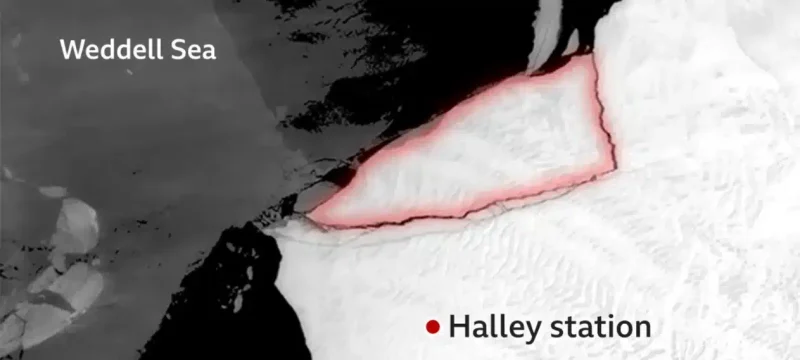Another large iceberg has broken away from the Antarctic region where the UK’s Halley research station is located, marking the third such event in the past three years. The new iceberg, measuring approximately 380 sq km (145 sq miles)—about the size of the Isle of Wight—originated from the Brunt Ice Shelf.
The British Antarctic Survey (BAS) had preemptively relocated the Halley station in 2017 due to concerns over the unstable ice conditions. The station, which now operates on skis to facilitate movement, is vacated during the harsh southern winter months, with the last personnel having departed in February.
The Brunt Ice Shelf is a floating extension of glaciers flowing off the Antarctic continent into the Weddell Sea. The shelf has been experiencing significant calving events, including the separation of a 1,300 sq km iceberg in 2021 (A74) and a 1,500 sq km iceberg in 2023 (A81). The latest iceberg was formed following a major crack detected on October 31, 2016, known as the “Halloween Crack.” A further fracture perpendicular to this crack has now created a free-floating ice segment that is drifting into the Weddell Sea.
Also Read: New Eruption Sparks Concern for Icelandic Town
The breakaway was detected using two GPS instruments placed on the anticipated iceberg. These instruments indicated substantial movement, which was later confirmed by satellite imagery showing the iceberg surrounded by seawater on all sides. The loss of such large ice masses has accelerated the seaward movement of the Brunt Ice Shelf, which is now moving at a rate of about 1,300m (4,300ft) per year, compared to the historical rate of 400-800m (1,300-2,600ft) per year.
The Brunt Ice Shelf has hosted a British research base since 1956 and is one of the two main UK science centers in Antarctica, alongside the Rothera Research Station. BAS, along with the UK’s Foreign, Commonwealth and Development Office, has initiated a project to understand the long-term implications of these calving events for the safety of the Halley station.
Remote sensing specialist Prof. Adrian Luckman from Swansea University noted that the recent calving has reduced the Brunt Ice Shelf to its smallest observed size and increased its dynamic activity. He suggested that this could indicate the end of a dynamic readjustment period, but only time will reveal whether the ice shelf stabilizes.
Icebergs are named according to a classification system managed by the US National Ice Center (USNIC), with the latest iceberg likely to be designated as A83. The USNIC will issue a bulletin announcing this new iceberg, which needs to be tracked due to its significant size and potential navigation hazards.







